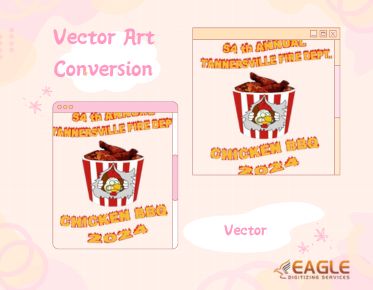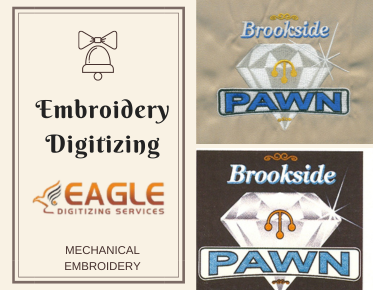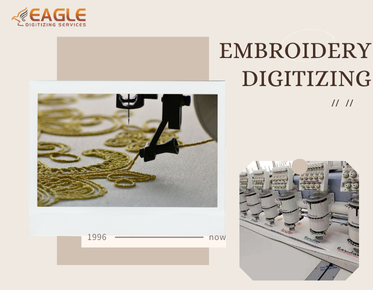Discover the Best Spots for DIY Silk Screen Printing Supplies
Diving into DIY silk screen printing is
a thrilling venture for creatives. Whether you're a novice or a seasoned
artist, sourcing the right materials is key to a successful project. Let's
explore where to find everything you need to start printing like a pro. Read Here are Some Things That You Should Know When It Comes To Embroidery Digitizing!
Getting
Started with Silk Screen Printing
What is Silk Screen Printing?
Silk screen printing, also known as screen printing, is a technique where ink is pushed through a mesh stencil onto
a substrate, typically fabric or paper. This method allows for vibrant,
long-lasting prints and is favored for its versatility and precision.
Benefits of DIY Silk Screen
Printing
Creating your own screen prints opens up a world of customization and
creative control. You can produce unique designs, tailor projects to specific
needs, and enjoy the satisfaction of making something from scratch. Plus, it's
a cost-effective way to produce high-quality prints.
Basic Materials You’ll Need
To get started, you'll need a few essential materials: a screen, squeegee, photo emulsion, ink, and a light source to expose your design. Additionally, having a sturdy frame, tape, and a washing setup will make the process smoother.
Local
Art Supply Stores
Finding Nearby Art Supply Shops
Local art supply stores are a great first stop. A quick online search
or a look through community boards can help you locate nearby shops.
What to Look for in a Store
Seek out stores with knowledgeable staff and a wide range of products.
Quality materials and brands like Speedball, Jacquard, and Permaset should be
readily available.
Popular Chains and Independent
Stores
Chains like Blick Art Materials and Michaels are reliable choices but don't overlook independent stores. These shops often carry unique supplies and offer personalized service.
Online
Retailers for Silk Screen Supplies
Top Websites for Printing
Materials
Websites like Blick, Dharma Trading Co., and Amazon offer extensive
selections of screen printing supplies. These platforms provide convenience and
competitive pricing.
Comparing Prices and Shipping
Options
When shopping online, compare prices across multiple sites and
consider shipping costs. Some retailers offer free shipping on large orders,
which can save you money.
Customer Reviews and Recommendations
Check customer reviews and ratings to gauge product quality and seller reliability. User feedback can offer valuable insights into the performance of different materials.
Specialty
Screen Printing Suppliers
Dedicated Screen Printing Shops
Specialty suppliers focus solely on screen printing, providing
high-quality, professional-grade materials. Ryonet and ScreenPrinting.com are
popular choices.
Advantages of Buying from
Specialists
These suppliers offer a deeper range of products and expert advice.
They often provide technical support and resources for troubleshooting common
issues.
How to Find Local and Online
Suppliers
A targeted online search or industry directories can help you locate specialty suppliers. Networking with local artists can also lead to valuable recommendations.
Big-Box
Stores and General Retailers
Surprising Finds at Major
Retailers
Big-box stores like Walmart and Target might not be the first places
you think of, but they often carry basic screen printing supplies in their
craft sections.
What Sections to Check
Look in the arts and crafts, home improvement, and office supply
sections. You might find screens, inks, and other essentials at competitive
prices.
Pros and Cons of Big-Box Stores
While convenient and often cheaper, big-box stores may offer limited variety and lower-quality materials compared to specialized suppliers.
Thrift
Stores and Secondhand Shops
Hunting for Hidden Gems
Thrift stores and secondhand shops can be treasure troves for DIY
materials. Keep an eye out for frames, fabric, and other items that can be
repurposed for screen printing.
Reusing and Upcycling Materials
Upcycling old screens, fabrics, and frames is not only eco-friendly
but also cost-effective. You can frequently obtain high-quality materials at a
fraction of the cost.
Cost-Effective Shopping Tips
Frequent visits and a bit of patience can lead to great finds. Join local thrift store mailing lists for updates on new arrivals and sales.
DIY
and Craft Stores
Chains Like Michaels and Joann
Fabrics
These stores are well-known for their wide range of crafting supplies,
including screen printing kits and individual components.
What They Offer for Screen
Printing
You'll find screens, inks, emulsions, and tools. They also stock blank
shirts, totes, and other items perfect for printing.
Sales and Coupons to Look Out
For
Sign up for newsletters and download store apps to access coupons and sales. Michaels and Joann Fabrics frequently offer discounts that can save you money.
Wholesale
Suppliers
Buying in Bulk for Savings
If you're planning large projects or starting a small business, buying
in bulk from wholesale suppliers like Alibaba or ULINE can be highly economical.
How to Qualify for Wholesale
Accounts
Some wholesalers require proof of business, such as a tax ID number.
Check the supplier's requirements and be prepared to provide necessary
documentation.
Best Wholesale Suppliers for
Screen Printing
Ryonet and McLogan Supply are excellent options for wholesale screen printing materials. They offer bulk pricing and a wide range of products.
Local
Print Shops and Businesses
Building Relationships with
Local Printers
Developing relationships with local print shops can be beneficial.
They can offer advice, surplus materials, and even collaboration opportunities.
Purchasing Surplus Materials
Local printers often have surplus materials that they sell at
discounted prices. This can be a great way to obtain high-quality supplies
affordably.
Networking for Better Deals
Networking within your local arts community can lead to exclusive deals and insider tips on where to find the best materials.
Community
Resources and Freecycling
Joining Local Art Groups and
Communities
Local art groups and online communities can be valuable resources.
Members often share tips and may even have materials to give away or sell.
Freecycling Networks and
Exchanges
Websites like Freecycle and local exchange groups on social media are
great for finding free or low-cost materials. Keep an eye out for posts
offering screen printing supplies.
Finding Free or Discounted
Supplies
Participate actively in these communities. Offering your own unused supplies can also lead to reciprocal generosity.
Online
Marketplaces
eBay, Etsy, and Other
Marketplaces
Platforms like eBay and Etsy offer a wide range of new and used screen
printing supplies. These marketplaces are great for finding unique and vintage
items.
Tips for Finding Good Deals
Set alerts for specific items and regularly check listings to snag the
best deals. Negotiating with sellers can also result in lower prices.
Seller Ratings and Product
Reviews
Always check seller ratings and read product reviews to ensure you're buying from reputable sources. This can prevent disappointing purchases.
Social
Media and Online Groups
Facebook Marketplace and Groups
Facebook Marketplace and groups dedicated to screen printing are
excellent places to find materials. You can also join community groups for
advice and support.
Reddit Communities and Forums
Subreddits like r/screenprinting are full of tips, tricks, and
material recommendations. Engaging with these communities can provide valuable
insights.
Networking for Tips and
Materials
Active participation in online groups can lead to networking opportunities. Members often share information about where to find the best materials.
DIY
Kits for Beginners
All-in-One Kits for Starters
DIY kits are perfect for beginners. They typically include everything
you need to get started, from screens and squeegees to inks and emulsions.
What’s Included in a Kit
Most kits include a screen, squeegee, photo emulsion, ink, and
detailed instructions. Some also come with designs and practice materials.
Best Kits on the Market
Speedball and Jacquard offer highly-rated starter kits that are perfect for newcomers. These kits provide a comprehensive introduction to screen printing.
Custom
Suppliers for Unique Needs
Ordering Custom Screens and Inks
For specific projects, custom screens and inks might be necessary.
Companies like Anthem Screen Printing offer personalized services to meet
unique needs.
Personalized Service for Special
Projects
Custom suppliers provide tailored solutions, ensuring you get the
exact materials you need. This can be especially useful for complex or
large-scale projects.
Finding Niche Suppliers
Niche suppliers can be found through industry networks, online searches, and trade shows. These specialists offer products that cater to specific requirements.
Eco-Friendly
and Sustainable Options
Sourcing Sustainable Materials
Eco-conscious printers can source sustainable materials such as
organic fabrics and biodegradable inks. Companies like Eco-Friendly Screen
Printing Supplies offer green alternatives.
Eco-Friendly Inks and Fabrics
Water-based inks and organic cotton are excellent choices for
eco-friendly printing. These materials reduce environmental impact and appeal
to conscious consumers.
Companies Committed to
Sustainability
Brands like Green Galaxy and Permaset are committed to providing sustainable screen printing supplies. Supporting these companies aligns your business with eco-friendly practices.
Budget-Friendly
Alternatives
Saving Money on Supplies
Buying in bulk, reusing materials, and taking advantage of sales are
great ways to save money. Thrift stores and secondhand shops can also offer
cost-effective alternatives.
DIY Hacks and Workarounds
DIY hacks such as creating your own screens or using household items
can reduce costs. Online tutorials provide creative solutions to traditional
methods.
Creative Substitutes for
Traditional Materials
Consider using unconventional materials like old picture frames for screens or homemade inks. These substitutes can be both budget-friendly and innovative.
Tools
and Equipment
Essential Tools for DIY Silk
Screen Printing
Key tools include a screen, squeegee, photo emulsion, and a light
source. Optional but helpful tools include a heat gun and drying rack.
Where to Buy Quality Equipment
Quality equipment can be found at art supply stores, online retailers,
and specialty suppliers. Investing in good tools ensures better print quality
and durability.
Maintaining Your Printing Gear
Regular maintenance of your equipment, such as cleaning screens and squeegees after each use, prolongs their lifespan and ensures consistent results.
Inks
and Emulsions
Types of Inks for Screen
Printing
Inks come in various types, including water-based, plastisol, and
discharge inks. Each type offers different benefits and applications.
Best Brands and Where to Buy
Them
Top brands include Speedball, Jacquard, and Permaset. These can be
purchased from art supply stores, specialty shops, and online retailers.
Tips for Choosing the Right
Emulsion
Select an emulsion compatible with your ink type and exposure setup. Diazo and photopolymer emulsions are popular choices, each with its own advantages.
Fabric
and Substrates
Best Fabrics for Screen Printing
Cotton, polyester, and blends are common fabrics for screen printing.
Each fabric type interacts differently with inks, affecting print quality and
durability.
Where to Buy Quality Fabric
Quality fabrics can be sourced from textile shops, online fabric
retailers, and craft stores. Look for reputable suppliers to ensure consistent
material quality.
Exploring Different Substrate
Options
Screen printing isn't limited to fabric. You can print on paper, wood, metal, and more. Experimenting with different substrates can expand your creative possibilities.
Finding materials for DIY silk screen printing is easier than you
might think, with options ranging from local stores to online marketplaces.
Additionally, Eagle Digitizing offers vector conversion services to help you achieve precise and professional results. Embark on
your screen printing journey with confidence, knowing where to source
high-quality supplies. Whether you're a hobbyist or aspiring professional, the
right materials can set you up for creative success. Happy printing!



